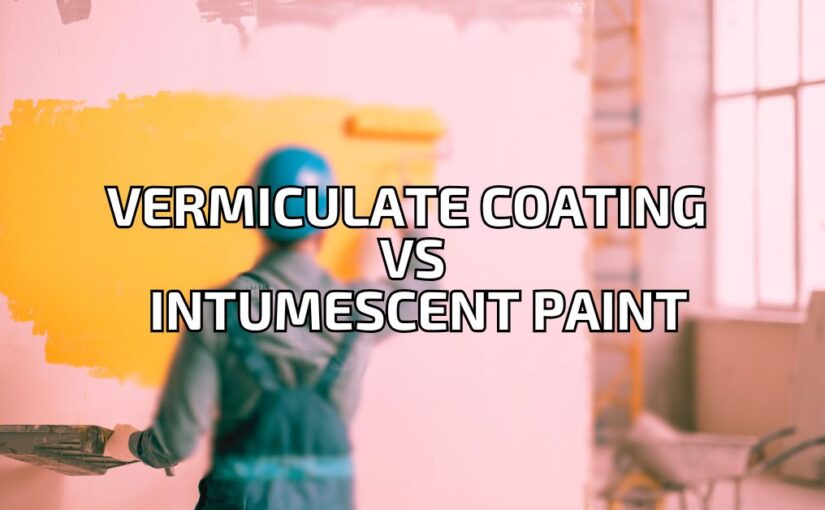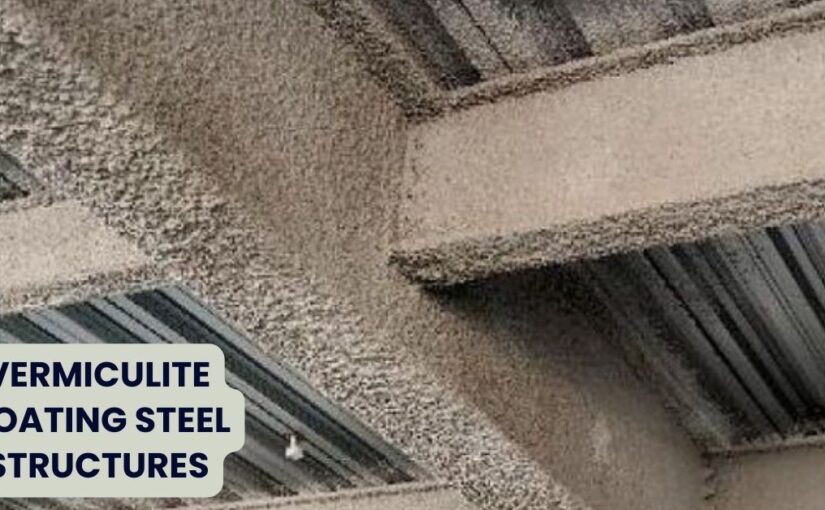Fire protection is an important aspect of building safety, particularly in commercial and industrial structures where fire hazards post great risks. Vermiculate coating and Intumescent Paint are the two major and commonly used fire proofing methods.
Both vermiculate fireproofing and intumescent paint are designed to enhance fire resistance; they differ in application, composition, effectiveness and suitability for various environments.
What are fire protection coatings?
Fire protection for steel structures is the passive fire protection, designed to contain and slow down the fire spread without active intervention. These coatings protect the structural elements by delaying their exposure to extreme temperatures, minimizing the likelihood of collapse.
Vermiculate coating is a cementitious fireproofing material made with vermiculate gypsum and other insulating compounds. The intumescent paint is a fire resistant paint that expands when exposed to heat, forming an insulated chat that protects the underlying surface.
What is Vermiculate Fireproofing?
Vermiculate spray is a light-weight fire retardant made of vermiculite or other lightweight elements mixed with heat absorbing materials like Gypsum. The coating insulates the steel structure from effects of high temperatures and extends the time for structural steel to retain its integrity and stability during the rising temperatures.
The coating provides high fire resistance and can withstand extreme temperatures, protecting the structures up to 4 hours. The spray is highly resistant to wear, impact and environmental damage. Made, from non-toxic natural materials, vermiculate spray is eco-friendly, affordable and ideal for large scale applications.
Vermiculate spray has varied applications including industrial buildings, structural steel protection, warehouses, factories, power plants, fireproofing tunnels and underground structures.
What is Intumescent Paint?
Intumescent Paint for steel is a fire-resistant coating that expands when exposed to heat. The paint forms an insulating char that slows down heat transfer to the structural material below. The paint is lightweight and does not add significant weight to the structure.
Known as one of the best steel fireproofing methods, intumescent paint offers a smooth, paint-like finish apt for exposed architectural elements. The paint can be applied on various surfaces including steel, wood and concrete.
Intumescent paint is used in varied applications like commercial buildings and offices, exposed structural steel, high-end residential projects and public buildings like malls and airports.
Best fireproof coating for Steel – Vermiculate paint or Intumescent spray
Fireproof coatings play a key role in protecting buildings and steel structures from fire damage. The two commonly used options are vermiculate paint and Intumescent paint. Both these fireproofing methods enhance fire resistance; they are different in composition, application and protection level.
- Fire Resistance Performance: The vermiculate paint provides four hours or fire resistance making it ideal for high-risk fire environments. The intumescent paint provides up to 2 hours of fire resistance, making vermiculate spray ideal for extended fire resistance.
- Heat Insulation effectiveness: The vermiculate spray act as a thick thermal barrier, reducing heat transfer to steel. The intumescent paint expands when exposed to fire but does not offer the same level of heat insulation as vermiculate coatings.
- Structural Impact and Durability: The vermiculate paint is highly durable, resistant to wear, impact and harsh weather conditions. The intumescent paint is prone to weathering and requires regular maintenance or reapplication.
- Aesthetic and Application: Vermiculate paint is thick and rough in appearance, often not suitable for exposed steel structures in commercial spaces and places where aesthetics is important. Intumescent paint has a smooth finish and is ideal for architectural designs and visible steel structures.
- Application process: Vermiculate spray is thick and requires professional spraying and extended drying time. The paint adds weight to the structure, which may not be ideal for all the buildings. Intumescent paint is easy and is applied using standard painting methods like rolling, spraying or brushing. It is light in weight, making it apt for weight-sensitive structures.
- Cost: Vermiculate Spray is more cost-effective and is ideal for large-scale fireproofing projects. Intumescent paint is more expensive, especially when applied over large areas or in multiple layers.
Fire protection is important for building safety, particularly structural steel. Understanding Vermiculate vs Intumescent Paint provides an in-depth comparison of both to determine which fire protection better suits your project.
When to choose Vermiculate Paint?
- The paint is ideal for industrial buildings – factories, warehouses and power plants.
- It is ideal for structural steel hidden behind walls or ceilings.
- Large-scale fireproofing projects that need longer fire resistance.
When to choose Intumescent Paint?
- This paint is apt for commercial buildings- offices, malls and airports.
- It is ideal for exposed structural steel requiring a smooth finish.
- The paint is perfect for lightweight applications and modern architecture.
For superior fire resistance and durability, Vermiculate Paint is a go-to choice. The choice depends on project requirements, for instance, high fire resistance and durability favour vermiculate paint, while aesthetic and lightweight needs make Intumescent paint a better alternative.
FAQs
- What is Vermiculate Spray?
Vermiculate Spray is a cementitious fireproofing coating made from vermiculite, gypsum and other insulating materials. It is spray-applied in thick layers to protect steel and concrete structures from high temperatures. JPSC Solutions best quality vermiculate spray is widely used in varied applications offering robust fire protection to the structures. - What is Intumescent Paint?
Intumescent Paint is a fire-resistant coating that expands when exposed to high temperatures, forming an insulating char that protects building structures. This paint provides up to 2 hours of fire resistance while maintaining a smooth paint-like finish. - Which among Vemiculate vs Intumescent Paiint is better for the structural steel?
Vermiculate paint is better for structural steel due to its higher fire resistance and superior durability while Intumescent paint is preferred for exposed steel in aesthetic application. - What are the applications of Vermiculate Paint?
JPSC Solutions quality Vermiculate paint is used for fireproofing industrial buildings, warehouses, factories, power plants, tunnels and hidden structural steel in high-risk environments. - What are the applications of Intumescent paint?
Intumescent paint is used for fireproofing exposed structural steel in commercial buildings, offices, malls, airports, high-end residential projects and modern architectural structures.


